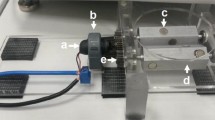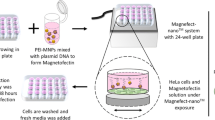Abstract
This chapter describes how to design and conduct experiments to deliver siRNA to adherent mammalian cells in vitro by magnetic force–assisted transfection using self-assembled complexes of small interfering RNA (siRNA) and cationic lipids or polymers that are associated with magnetic nanoparticles. These magnetic complexes are targeted to the cell surface by the application of a magnetic gradient field. In this chapter, first we describe the synthesis of magnetic nanoparticles for magnetofection, and association of siRNA with the magnetic components of the transfection complex. Second, a simple protocol is described in order to evaluate magnetic responsiveness of the magnetic siRNA transfection complexes and estimate the complex loading with magnetic nanoparticles. Third, protocols are provided for the preparation of magnetic lipoplexes and polyplexes of siRNA, magnetofection, downregulation of gene expression, and the determination of cell viability. The addition of INF-7 peptide, a fusogenic peptide, to the magnetic transfection triplexes improved gene silencing in HeLa cells. The described protocols are also valuable for screening vector compositions and novel magnetic nanoparticle preparations to optimize siRNA transfection by magnetofection in every cell type.
Access this chapter
Tax calculation will be finalised at checkout
Purchases are for personal use only
Similar content being viewed by others
References
Plank, C., Scherer, F., Schillinger, U., and Anton, M. (2000) Magnetofection: enhancement and localization of gene delivery with magnetic particles under the influence of a magnetic field. J. Gene. Med., 2, 24.
Mah , C. Zolotukhin, I., Fraites, T.J., Dobson, J., Batich, C., Byrne, B.J. (2000) Microsphere-mediated delivery of recombinant AAV vectors in vitro and in vivo . Mol. Ther. , 1 , S239 .
Hughes, C., Galea-Lauri, J., Farzaneh, F., and Darling, D. (2001) Streptavidin paramagnetic particles provide a choice of three affinity-based capture and magnetic concentration strategies for retroviral vectors. Mol. Ther., 3, 623–630.
Scherer, F., Anton, M., Schillinger, U., Henke, J., Bergemann, C., Kruger, A., Gansbacher, B., and Plank, C. (2002) Magnetofection: enhancing and targeting gene delivery by magnetic force in vitro and in vivo. Gene Ther., 9, 102–109.
Mah, C., Fraites, T.J., Jr., Zolotukhin, I., Song, S., Flotte, T.R., Dobson, J., Batich, C., and Byrne, B.J. (2002) Improved method of recombinant AAV2 delivery for systemic targeted gene therapy. Mol. Ther., 6, 106–112.
Pandori, M.W., Hobson, D.A., and Sano, T. (2002) Adenovirus-microbead conjugates possess enhanced infectivity: A new strategy to localized gene delivery. Virology, 299, 204–212.
Plank, C., Anton, M., Rudolph, C., Rosenecker, J., and Krotz, F. (2003) Enhancing and targeting nucleic acid delivery by magnetic force. Expert Opin. Biol. Ther., 3, 745–758.
Schillinger, U., Brill, T., Rudolph, C., Huth, S., Gersting, S., Krotz, F., Hirschberger, J., Bergemann, C., and Plank, C. (2005) Advances in magnetofection - magnetically guided nucleic acid delivery. J. Magn. Magn. Mater., 293, 501–508.
Huth, S., Lausier, J., Gersting, S.W., Rudolph, C., Plank, C., Welsch, U., and Rosenecker, J. (2004) Insights into the mechanism of magnetofection using PEI-based magnetofectins for gene transfer. J. Gene Med., 6, 923–936.
Krotz, F., de Wit, C., Sohn, H.Y., Zahler, S., Gloe, T., Pohl, U., and Plank, C. (2003) Magnetofection--a highly efficient tool for antisense oligonucleotide delivery in vitro and in vivo. Mol. Ther., 7, 700–710.
Plank, C., Schillinger, U., Scherer, F., Bergemann, C., Remy, J.S., Krotz, F., Anton, M., Lausier, J., and Rosenecker, J. (2003) The magnetofection method: using magnetic force to enhance gene delivery. Biol. Chem., 384, 737–747.
Dobson, J. (2006) Gene therapy progress and prospects: magnetic nanoparticle-based gene delivery. Gene Ther., 13, 283–287.
Doshida, M., Ohmichi, M., Tsutsumi, S., Kawagoe, J., Takahashi, T., Du, B., Mori-Abe, A., Ohta, T., Saitoh-Sekiguchi, M., Takahashi, K. et al. (2006) Raloxifene increases proliferation and up-regulates telomerase activity in human umbilical vein endothelial cells. J. Biol. Chem., 281, 24270–24278.
Deleuze, V., Chalhoub, E., El-Hajj, R., Dohet, C., Le Clech, M., Couraud, P.O., Huber, P., and Mathieu, D. (2007) TAL-1/SCL and its partners E47 and LMO2 up-regulate VE-cadherin expression in endothelial cells. Mol. Cell Biol., 27, 2687–2697.
McCaig, C., Duval, C., Hemers, E., Steele, I., Pritchard, D.M., Przemeck, S., Dimaline, R., Ahmed, S., Bodger, K., Kerrigan, D.D. et al. (2006) The role of matrix Metalloproteinase-7 in redefining the gastric microenvironment in response to Helicobacter pylori. Gastroenterology, 130, 1754–1763.
Uchida, Y., Ohshima, T., Sasaki, Y., Suzuki, H., Yanai, S., Yamashita, N., Nakamura, F., Takei, K., Ihara, Y., Mikoshiba, K. et al. (2005) Semaphorin3A signalling is mediated via sequential Cdk5 and GSK3β phosphorylation of CRMP2: implication of common phosphorylating mechanism underlying axon guidance and Alzheimer’s disease. Genes Cells, 10, 165–179.
Huang, P., Senga, T., and Hamaguchi, M. (2007) A novel role of phospho-[beta]-catenin in microtubule regrowth at centrosome. Oncogene, 26, 4357–4371.
Mizutani, T., Fukushi, S., Iizuka, D., Inanami, O., Kuwabara, M., Takashima, H., Yanagawa, H., Saijo, M., Kurane, I., and Morikawa, S. (2006) Inhibition of cell proliferation by SARS-CoV infection in Vero E6 cells. FEMS Immunol. Med. Microbiol., 46, 236–243.
Sapet, C., Simoncini, S., Loriod, B., Puthier, D., Sampol, J., Nguyen, C., Dignat-George, F., and Anfosso, F. (2006) Thrombin-induced endothelial microparticle generation: identification of a novel pathway involving ROCK-II activation by caspase-2. Blood, 108, 1868–1876.
Minami, R., Yamamoto, M., Takahama, S., Miyamura, T., Watanabe, H., and Suematsu, E. (2006) RCAS1 induced by HIV-Tat is involved in the apoptosis of HIV-1 infected and uninfected CD4+ T cells. Cell. Immunol., 243, 41–47.
Bonetta, L. (2005) The inside scoop—evaluating gene delivery methods. Nat. Methods, 2, 875–883.
Smith, C. (2006) Sharpening the tools of RNA interference. Nat. Methods, 3, 475–486.
Felgner, P.L., Barenholz, Y., Behr, J.P., Cheng, S.H., Cullis, P., Huang, L., Jessee, J.A., Seymour, L., Szoka, F., Thierry, A.R. et al. (1997) Nomenclature for synthetic gene delivery systems. Hum. Gene Ther., 8, 511–512.
Mykhaylyk, O., Vlaskou, D., Tresilwised, N., Pithayanukul, P., Moller, W., and Plank, C. (2007) Magnetic nanoparticle formulations for DNA and siRNA delivery. J. Magn. Magn. Mater., 311, 275–281.
Terebesi, J., Kwok, K.Y., and Rice, K.G. (1998) Iodinated plasmid DNA as a tool for studying gene delivery. Anal. Biochem., 263, 120–123.
Azzam, T. and Domb, A.J. (2004) Current developments in gene transfection agents. Curr. Drug Deliv., 1, 165–193.
Plank, C., Oberhauser, B., Mechtler, K., Koch, C., and Wagner, E. (1994) The influence of endosome-disruptive peptides on gene transfer using synthetic virus-like gene transfer systems. J. Biol. Chem., 269, 12918–12924.
Plank, C., Zauner, W., and Wagner, E. (1998) Application of membrane-active peptides for drug and gene delivery across cellular membranes. Adv. Drug Deliv. Rev., 34, 21–35.
Funhoff, A.M., van Nostrum, C.F., Lok, M.C., Fretz, M.M., Crommelin, D.J., and Hennink, W.E. (2004) Poly(3-guanidinopropyl methacrylate): a novel cationic polymer for gene delivery. Bioconjug. Chem., 15, 1212–1220.
Jiang, X., Lok, M.C., and Hennink, W.E. (2007) Degradable-brushed pHEMA-pDMAEMA synthesized via ATRP and click chemistry for gene delivery. Bioconjug. Chem., 18, 2077–2084.
Oliveira, S., van Rooy, I., Kranenburg, O., Storm, G., and Schiffelers, R.M. (2007) Fusogenic peptides enhance endosomal escape improving siRNA-induced silencing of oncogenes. Int. J. Pharm., 331, 211–214.
Kowalski, J.B. and Tallentire, A. (1999) Substantiation of 25 kGy as a sterilization dose: a rational approach to establishing verification dose. Radiat. Phys. Chem., 54, 55–64.
Gersdorff, K. von. (2006) PEG-shielded and EGF receptor-targeted DNA polyplexes: Cellular mechanisms. Ph D Thesis, Ludwig Maximilian University, Munich, Germany, Supervisor Prof. Dr. E. Wagner. 125 pp. http://edoc.ub.uni-muenchen.de/5485/.
Berridge, M.V., Herst, P.M., and Tan, A.S. (2005) Tetrazolium dyes as tools in cell biology: new insights into their cellular reduction. Biotechnol. Annu. Rev., 11, 127–152.
Berridge, M.V., Tan, A.S., and Hilton, C.J. (1993) Cyclic adenosine monophosphate promotes cell survival and retards apoptosis in a factor-dependent bone marrow-derived cell line. Exp. Hematol., 21, 269–276.
Suzuki, M., Mikami, T., Matsumoto, T., and Suzuki, S. (1977) Preparation and antitumor activity of O-palmitoyldextran phosphates, O-palmitoyldextrans, and dextran phosphate. Carbohydr. Res., 53, 223–229.
Snyder, F. and Stephens, N. (1959) A simplified spectrophotometric determination of ester groups in lipids. Biochim. Biophys. Acta, 34, 244–245.
Wilhelm, C., Gazeau, F., and Bacri, J.C. (2002) Magnetophoresis and ferromagnetic resonance of magnetically labeled cells. Eur. Biophys. J., 31, 118–125.
Esbjorner, E.K., Oglecka, K., Lincoln, P., Graslund, A., and Norden, B. (2007) Membrane binding of pH-sensitive Influenza fusion peptides. Positioning, configuration, and induced leakage in a lipid vesicle model. Biochemistry, 46, 13490–13504.
Acknowledgments
The authors would like to thank Dr. Bob Scholte for transduction of the H441 cells with eGFP and luciferase using lentiviral vectors. This work was supported by the European Union through the FP6-LIFESCIHEALTH Project “Improved precision of nucleic acid based therapy of cystic fibrosis” under contract no. 005213 as well as by the German Ministry of Education and Research, Nanobiotechnology grants 13N8186 and 13N8538. Financial support of the German Excellence Initiative via the “Nanosystems Initiative Munich (NIM)” is gratefully acknowledged.
Author information
Authors and Affiliations
Editor information
Editors and Affiliations
Rights and permissions
Copyright information
© 2009 Humana Press, a part of Springer Science+Business Media, LLC
About this protocol
Cite this protocol
Mykhaylyk , O., Zelphati , O., Hammerschmid , E., Anton , M., Rosenecker , J., Plank , C. (2009). Recent Advances in Magnetofection and Its Potential to Deliver siRNAs In Vitro. In: Sioud, M. (eds) siRNA and miRNA Gene Silencing. Methods in Molecular Biology, vol 487. Humana Press. https://doi.org/10.1007/978-1-60327-547-7_6
Download citation
DOI: https://doi.org/10.1007/978-1-60327-547-7_6
Published:
Publisher Name: Humana Press
Print ISBN: 978-1-60327-546-0
Online ISBN: 978-1-60327-547-7
eBook Packages: Springer Protocols




